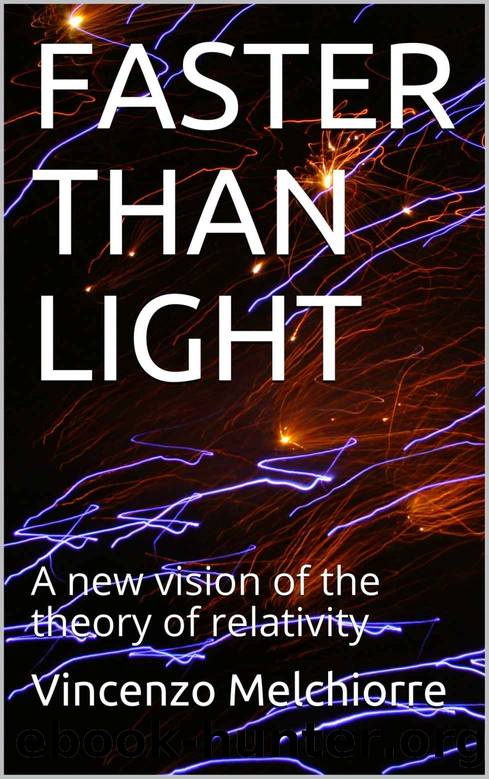FASTER THAN LIGHT: A new vision of the theory of relativity by Vincenzo Melchiorre

Author:Vincenzo Melchiorre [Melchiorre, Vincenzo]
Language: eng
Format: mobi
Published: 2018-12-04T16:00:00+00:00
V= â v1 + v2
1+v1xv2/"c 2"
In it was introducing the speed of light "c" with the aim of justifying the statement that the speed of light is a constant and also a speed limit.
In fact, using this formula, whatever the values of the two velocities v1 and v2 the result that derives from it is always inferior or at the maximum equal to "c".
It is a formula conceived in such a way as to support the basic principle of the theory of relativity and that is that the speed of light is fixed and immutable and represents an insurmountable limit.
I repeat: the speed of light is something anomalous compared to the speed of all the other bodies, it is a peculiarity of electromagnetic waves and, therefore, can not appear in a formula for speed composition.
Einstein himself assert that it is non composed with the speed of the bodies and, therefore, can not interfere with their motion, nor be modified by it.
In my opinion, therefore, the post-relativistic composition formula lead to erroneous result because it claims to introduce the speed of light
in the composition of the velocities of the bodies to which it is completely extraneous for all off the above.
The speed of light should be taken into consideration only when measuring the speed of a body since electromagnetic waves must be used to make such measurement.
In this regard, however, it must be said that, since the speed of light is fixed and in vacuum is equal to 300,000 Km/sec, it can only be used by subjects that move at relative speeds lower than "c"; otherwise no contact between them would be possible.
In my opinion, the speed of light represents a limit only in relation to the contacts that different subjects may have between them, but it can not constitute a limit for their relative velocities, which may, therefore, be even higher than "c".
I give an example
Suppose we find ourselves on a spaceship and start in the direction of a star that is moving away from us at a speed of 5/6 of "c" , ie about 250,000 Km/sec.
Now suppose that our spaceship is able to move at a speed of 1/3 of "c", about 100,000 Km/sec, then the star will move away from us at a speed of 150,000 Km/sec.
Download
This site does not store any files on its server. We only index and link to content provided by other sites. Please contact the content providers to delete copyright contents if any and email us, we'll remove relevant links or contents immediately.
The Art of Thinking Clearly by Rolf Dobelli(10132)
Mindhunter: Inside the FBI's Elite Serial Crime Unit by John E. Douglas & Mark Olshaker(9099)
Change Your Questions, Change Your Life by Marilee Adams(7557)
Nudge - Improving Decisions about Health, Wealth, and Happiness by Thaler Sunstein(7456)
Mastermind: How to Think Like Sherlock Holmes by Maria Konnikova(7154)
The Power of Now: A Guide to Spiritual Enlightenment by Eckhart Tolle(5529)
Men In Love by Nancy Friday(5108)
Altered Sensations by David Pantalony(5001)
Factfulness: Ten Reasons We're Wrong About the World – and Why Things Are Better Than You Think by Hans Rosling(4620)
The Confidence Code by Katty Kay(4153)
Thinking in Bets by Annie Duke(4117)
Man and His Symbols by Carl Gustav Jung(4004)
The Worm at the Core by Sheldon Solomon(3394)
Why Buddhism is True by Robert Wright(3370)
Three Women by Lisa Taddeo(3319)
Liar's Poker by Michael Lewis(3316)
The Inner Life of Animals by Peter Wohlleben(3193)
Descartes' Error by Antonio Damasio(3185)
The Power of Mindful Learning by Ellen J. Langer(3128)
